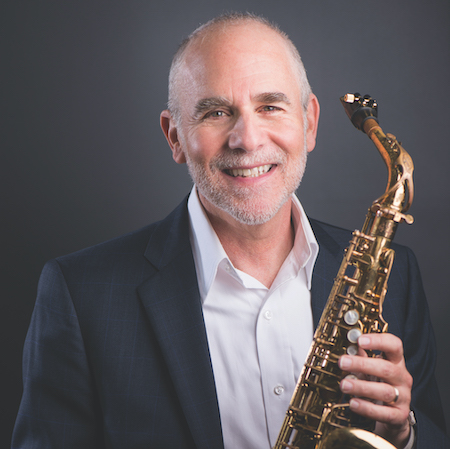Dec 9, 2025 12:28 PM
In Memoriam: Gordon Goodwin, 1954–2025
Gordon Goodwin, an award-winning saxophonist, pianist, bandleader, composer and arranger, died Dec. 8 in Los Angeles.…

Jim Nadel
(Photo: Courtesy Stanford Jazz Workshop)When Jim Nadel presented the final concert of the 2022 Stanford Jazz Festival in late July, the newest entrant into the DownBeat Jazz Education Hall of Fame beamed with a well-earned sense of pride.
It was a night of mutual gratitude and admiration for the Stanford Jazz Workshop’s founder and artistic director as an all-star group he’d assembled with saxophonists Joshua Redman and Yosvany Terry, trumpeter Ambrose Akinmusire, pianist Taylor Eigsti, bassist Larry Grenadier and drummer Eric Harland took the stage of Stanford University’s historic Frost Amphitheatre. All members of that SJW 50th Anniversary Band had been campers at the legendary summer program save for Harland, but he has been a faculty member, and were on the first half of an impressive double bill that included vocalist Dianne Reeves’ quintet accompanied by an orchestra with music arranged and conducted by Vince Mendoza.
The festival, which ran from mid-June to the end of July and included 30 other concerts, runs parallel to the Summer Jazz Workshop and nearly always features musicians who are also teaching there. Students can attend these shows for free, so there’s a youthful energy emanating from the audience.
“One of the joys of having my job is you get to imagine an idea, and I’m often in a position to make it happen,” Nadel said during an interview in San Francisco’s Golden Gate Park. Whether it’s a one-time performance or conceiving a jazz education institution, Nadel’s career has been fueled by invention.
Nadel was a recent Stanford graduate when he launched SJW in the summer of 1972. The workshop’s growth from a modest local gathering to an international presence puts it in the impressive league of other one-time startups like Yahoo! and Google, which also have roots in the famed Stanford campus.
“That first year, we had a jam session in the Coffee House on Monday night,” he recalled. “And I invited anyone who wanted to come to a separate meeting on Tuesday night in the student union that was just going to be about talking about what to play the next week and approaches to the changes and what chords to maybe use on the bridge. And we’d play some vinyl and discuss what we were hearing. It was an open exchange.”
With a degree in Western music, Nadel felt he could help his fellow workshop comrades approach the jazz they all loved through a wider historical and theoretical lens.
“For the first 10 years, it was locally based,” he shared. “And then in 1982 we made the big change, because I tracked down Stan Getz. He came to Stanford for a week as our first artist-in-residence, and I took the plunge and bought our first ad ever in DownBeat.
“That got us some musicians from London, and people came from all over the United States,” he continued.
Subsequent Workshop educators/festival performers included Dizzy Gillespie, James Moody, Horace Silver, Ray Brown, Marc Johnson, Victor Lewis and many more.
“They should put up a statue of Jim Nadel on the Stanford campus,” wrote Ted Gioia in a 2015 email interview. “He has trained two generations of jazz players and has had a lasting positive impact on thousands of performers.”
On the summertime front, SJW now averages about 800 students a year. And the jam session concept on which SJW was founded remains both a formal and informal nightly practice for all.
“I like to think that everybody gets inspired and gets closer to the music when they come,” Nadel said. “We’re not in the business of producing the next generation of professional jazz musicians, though so many do come through. But I think there’s a place for music in everybody’s life. And you can get deeper into it by spending some time in a program like Stanford Jazz Workshop, and your life will be a little different in a positive way.”
For these reasons and more, Jim Nadel has been inducted into the DownBeat Jazz Education Hall of Fame. DB

Goodwin was one of the most acclaimed, successful and influential jazz musicians of his generation.
Dec 9, 2025 12:28 PM
Gordon Goodwin, an award-winning saxophonist, pianist, bandleader, composer and arranger, died Dec. 8 in Los Angeles.…

Belá Fleck during an interview with Fredrika Whitfield on CNN.
Jan 13, 2026 2:09 PM
The fallout from the renaming of the John F. Kennedy Center for the Performing Arts to include President Donald…

Flea has returned to his first instrument — the trumpet — and assembled a dream band of jazz musicians to record a new album.
Dec 2, 2025 2:01 AM
After a nearly five-decade career as one of his generation’s defining rock bassists, Flea has returned to his first…

Dec 11, 2025 11:00 AM
DownBeat presents a complete list of the 4-, 4½- and 5-star albums from 2025 in one convenient package. It’s a great…

“It’s a pleasure and an honor to interpret the music of Oscar Peterson in his native city,” said Jim Doxas in regard to celebrating the Canadian legend. “He traveled the world, but never forgot Montreal.”
Nov 18, 2025 12:16 PM
In the pantheon of jazz luminaries, few shine as brightly, or swing as hard, as Oscar Peterson. A century ago, a…